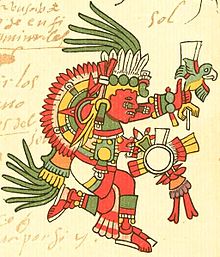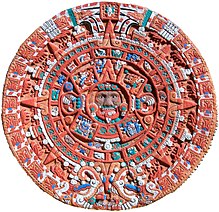Tonatiuh


Tonatiuh ( Nahuatl : tōnatiuh , "he goes there to warm / shine") was the god of the sun in Aztec mythology .
Appearance
Tonatiuh was associated with the eagle. On a disk of the sun he can be seen as an eagle diving (into the underworld), whose sticking out tongue thirsts for blood. Often he is also found as a warrior staring at arms on a disk of the sun surrounded by rays.
Assignments
Tonatiuh was considered to be the Fifth Sun to rule the present Four Earthquake Age after the Fourth Sun set . Since Toniatuh was venerated in the Toltec times , the Aztecs also called him the ruler of Tula . In the three-tier division of the afterlife, Tonatiuh was also seen as the ruler of the highest level, the house of the sun in the sky ( ichan tonatiuh ilhuicac ), where there are wild agaves and groves of acacias. It was the plane of heaven that was reserved for fallen warriors, sacrificed people, women who died in childbirth and those who died while traveling. In the Aztec calendar, the year was divided into thirteen-day sections ( Trecenas ). Tonatiuh was assigned to the Trecena from the 1st death to the 13th Feuerstein . This section was bordered by the Trecena Chalchiuhtlicues and the Tlalocs .
Creation myth
Aztec mythology divided the cosmic ages into five sections, each ruled by a sun. The first sun (four-jaguar) was ruled by the god of the jaguar sun , Ocelotonatiuh . The ruler of the second sun (four wind) was the god of wind Ehécatl . The ruler of the third sun (four rain) was the rain god Tlaloc, the fourth sun (four water) the water goddess Chalchiuhtlicue and the fifth sun Tonatiuh, who emerged from the leper Nanahuatzin after Nanahuatzin, more heroic than his competitor Tecciztecatl , threw at a stake. According to Aztec belief, the age of Tonatiuh would one day be destroyed by earthquakes.
Human sacrifice
The Aztecs believed that the sun burned out during its nocturnal journey through the underworld and that Tonatiuh therefore required human blood to recharge his batteries. If she did not get human blood, the sun would refuse to rise again. Correspondingly, the Aztecs watched the sun's course with fear and broke out into confusion when a solar eclipse darkened the day. Therefore Tonatiuh belongs to the Aztec gods, for whom the cruelty of the sacrificial cult was particularly active. The victims were held by four priests, while a fifth priest cut open his chest with an obsidian knife and held the torn heart towards the sun. There is no agreement on the number of victims. Estimates range up to 20,000 victims per year, although it is unclear whether this is true, or whether either the Aztecs exaggerated to intimidate their neighbors or the Spanish to explain the atrocities of the Conquista .
literature
- Heike Owusu: symbols of the Inca, Maya and Aztecs . Schirner Verlag Darmstadt (2000), ISBN 3-89767-073-9
- Günter Lanczkowski: The religion of the Aztecs, Maya and Inca . Scientific Book Society Darmstadt (1989), ISBN 3-534-03222-5
- Karl Taube : Aztec and Mayan Myths . Phillip Reclam jun. Stuttgart (1994), ISBN 3-15-010427-0
- George C. Vaillant: The Aztecs . M. Dumont Schaumberg Publishing House Cologne (1957)
- Jacques Soustelle: This is how the Aztecs lived on the eve of the Spanish conquest . German Publishing House Stuttgart (1956)
- Ursula Thiemer-Sachse : "Tonatiuh, the sun god of the Aztecs - the birth of the fifth sun". In: Amerindian Research No. 4, 2007
Web links
- Tonatiuh in the Azteccalendar (English)
- Gods of the Aztecs (English)
